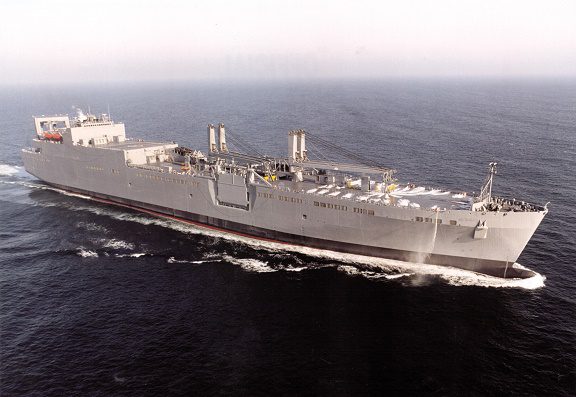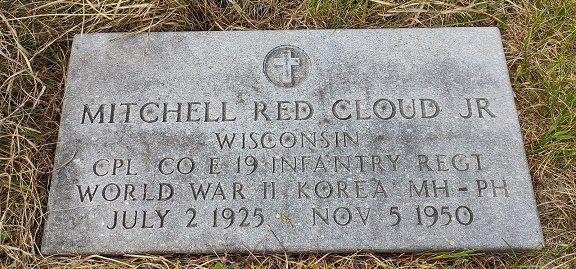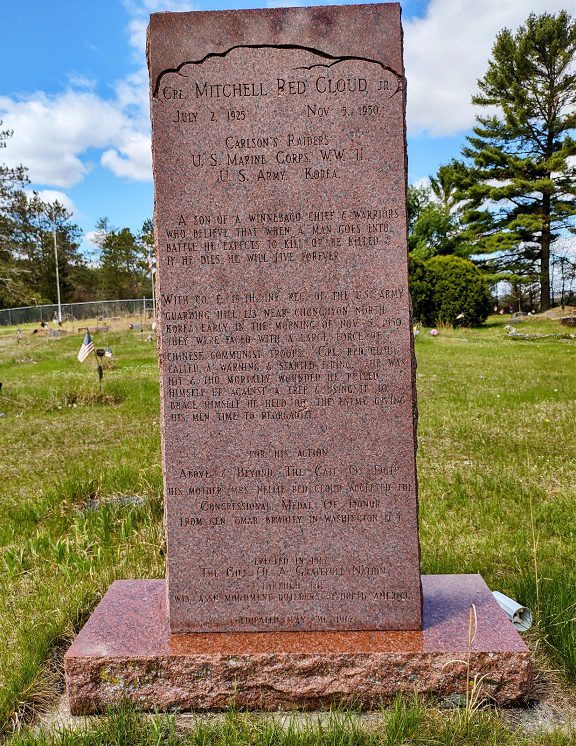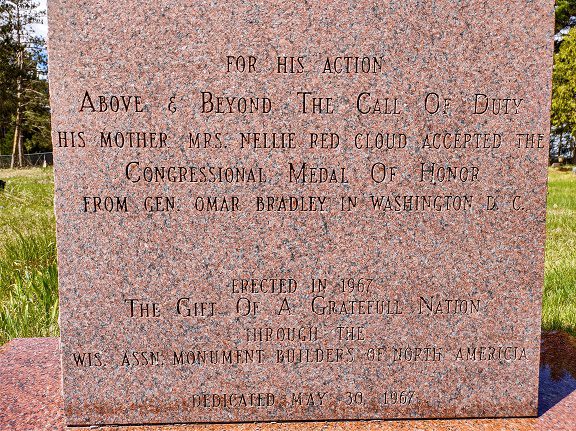By James Heinz
There are soldiers, and there are warriors. This is the story of a true American warrior, and of the ship that is named for him.

USNS RED CLOUD courtesy of Wikipedia
On January 18, 2000, the U.S. Navy placed into service a ship named the USNS RED CLOUD (T-AKR 313). She displaces 62,970 tons, and is 951 feet long and 106 feet wide. Her two gas turbine engines allows her 35 person crew to drive her at 24 knots for a distance of 12,000 miles.
She is part of the U.S. Navy’s Military Sealift Command. Navsource.org describes her function as “A non-combatant Large, Medium-Speed, Roll-on/Roll-off (LMSR) vessel, Red Cloud and other ships of her class are used to pre-position tanks, trucks, various wheeled vehicles and supplies needed to support an army heavy brigade.”
Navy.mil says that she “has a cargo carrying capacity of more than 380,000 square feet, equivalent to almost eight football fields. In addition, LMSRs have a slewing stern ramp and a removable ramp that services two side ports making it easy to drive vehicles on and off the ship. Interior ramps between six decks ease traffic flow once cargo is loaded aboard ship. Two 110-ton single-pedestal twin cranes make it possible to load and unload cargo where shoreside infrastructure is limited or nonexistent.”
RED CLOUD was launched on August 7, 1999, and was christened by the daughter of the man she named after. The man she is named after was a true American warrior.
Photo at top of page is Mitchell Red Cloud, Jr. courtesy of Wikipedia
Mitchell Red Cloud, Jr. was born in 1925 in Hatfield, Wis. He was a full-blooded member of the Ho-Chunk Nation. He dropped out of high school at age 16 to join the U.S. Marine Corps.
Mitchell joined the elite of the elite, the 2nd battalion of the Marine Raiders. He fought in the Battle of Guadalcanal, where he participated in the famous “Long Patrol”, during which he and his unit spent 28 days behind Japanese lines.
After the Long Patrol was over his entire unit was declared unfit for duty due to tropical disease. The enemy could not bring Mitchell down but the malaria that he contracted did, causing him to lose 75 pounds. He refused the offer of a medical discharge and requested re-assignment to a combat unit.
The Marines assigned Mitchell to the 29th Marine regiment. He then participated in the largest and bloodiest battle of the Pacific War, the Battle of Okinawa. Mitchell was wounded in the shoulder and evacuated to Guam. He was discharged at the end of the war as a sergeant.
That would have been enough war for most men, but in 1948 Mitchell enlisted in the 19th Infantry Regiment of the U.S. Army. In 1950 he and his unit were sent to Korea, where Mitchell’s previous combat experience was invaluable and he was promoted to corporal.
By November 1950 they had advanced to within 50 miles of the Chinese border. They thought the war was almost over and that they would be home for Christmas when on November 25th, Communist Chinese armies launched a surprise attack on United Nations forces along the Ch’ongch’on River.
The best explanation of what happened next can be found in the words of Mitchell Red Cloud’s Congressional Medal of Honor citation:
“Cpl. Red Cloud, Company E, distinguished himself by conspicuous gallantry and intrepidity above and beyond the call of duty in action against the enemy. From his position on the point of a ridge immediately in front of the company command post he was the first to detect the approach of the Chinese Communist forces and give the alarm as the enemy charged from a brush-covered area less than 100 feet from him. Springing up, he delivered devastating pointblank automatic rifle fire into the advancing enemy. His accurate and intense fire checked this assault and gained time for the company to consolidate its defense. With utter fearlessness he maintained his firing position until severely wounded by enemy fire. Refusing assistance, he pulled himself to his feet and, wrapping his arm around a tree, continued his deadly fire again, until he was fatally wounded. This heroic act stopped the enemy from overrunning his company’s position and gained time for reorganization and evacuation of the wounded. Cpl. Red Cloud’s dauntless courage and gallant self-sacrifice reflects the highest credit upon himself and upholds the esteemed traditions of the U.S. Army.”



Courtesy of Find a Grave
Mitchell’s body was recovered and buried with traditional Ho-Chunk ceremony in the Decorah Cemetery in Black River Falls, Wis. His mother received his Medal of Honor. An Army camp in Korea, and an American Legion post, a park, and a section of state highway 54 in Wisconsin are named for him.
And every July 4th, the Ho-Chunk Nation observes Corporal Mitchell Red Cloud, Jr. Day.
____________________________________
James Heinz is the Wisconsin Marine Historical Society’s acquisitions director. He became interested in maritime history as a kid watching Jacques Cousteau’s adventures on TV. He was a Great Lakes wreck diver until three episodes of the bends forced him to retire from diving. He was a University of Wisconsin – Milwaukee police officer for thirty years. He regularly flies either a Cessna 152 or 172.

